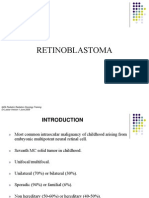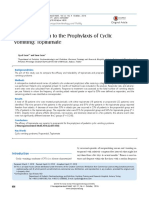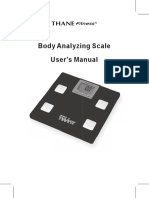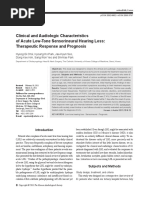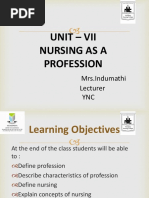Surgery Papillary Thyroid CA
Surgery Papillary Thyroid CA
Uploaded by
Melissa LabadorCopyright:
Available Formats
Surgery Papillary Thyroid CA
Surgery Papillary Thyroid CA
Uploaded by
Melissa LabadorOriginal Description:
Copyright
Available Formats
Share this document
Did you find this document useful?
Is this content inappropriate?
Copyright:
Available Formats
Surgery Papillary Thyroid CA
Surgery Papillary Thyroid CA
Uploaded by
Melissa LabadorCopyright:
Available Formats
DISCUSSION
THYROID
Anatomy
located adjacent to the throid cartilage
connected in the midline by an isthmus
pyramidal lobe is present in about 50% of patients
thyroid lobes extend to the midthyroid cartilage superiorly and lie
adjacent to carotid sheaths and sternocleidomastoid muscles laterally
thyroid gland is enveloped by a loosely connecting fascia that is
formed from the partition of the deep cervical fascia into anterior and
posterior divisions
true capsule of the thyroid is a thin, densely adherent fibrous layer
that sends out septa that invaginate into the gland, forming
pseudolobules
thyroid capsule is condensed into the posterior suspensory or berry's
ligament ner the cricoid cartilage and upper tracheal rings
blood supply: superior & inferior thyroid arteries, thyroidea ima
venous drainage: superior, middle & inferior thyroid veins
nerve supply: right & left recurrent laryngeal nerve and superior
laryngeal nerve
lymphatic drainage: Intraglandular lymphatic vessels connect both
thyroid lobes through the isthmus and also drain to perithyroidal
structures and lymph nodes. Regional lymph nodes include pretracheal,
paratracheal, perithyroidal, RLN, superior mediastinal, retropharyngeal,
esophageal, and upper, middle, and lower jugular chain nodes.
IMAGING
Iodine-123 and iodine-131
are used to image the thyroid gland
Iodine 123 emits lowdose radiation, has a half-life of 12 to 14 hours,
and is used to image lingual thyroids or goiters.
In contrast, iodine-131has a half-life of 8 to 10 days and leads to
higher-dose radiation exposure
Therefore, this isotope is used to screen and treat patients with differentiated
thyroid cancers for metastatic disease.
The imagesobtained by these studies provide information not only about the
size and shape of the gland, but also the distribution of functional activity.
Areas that trap less radioactivity than the surrounding gland are termed cold
(Fig. 38-10), whereas areas that demonstrate increased activity are termed
hot.
The risk of malignancy is higher in cold lesions (20%) compared to hot or
warm lesions (<5%).
Technetium Tc 99m pertechnetate (99mTc)
is taken up by the thyroid gland and is increasingly being used for
thyroid evaluation.
This isotope is taken up by the mitochondria, but is not organified.
It also has the advantage of having a shorter half-life and minimizes
radiation exposure.
It is particularly sensitive for nodal metastases.
More recently, 18F-fluorodeoxyglucose (FDG) positron emission
tomography (PET) combined with computed tomography (CT) is being
increasingly used to screen for metastases in patients with thyroid
cancer in whom other imaging studies are negative.
Ultrasound
an excellent noninvasive and portable imaging study of the thyroid gland with
the added advantage of no radiation exposure
helpful in the evaluation of thyroid nodules, distinguishing solid from cystic
ones, and providing information about size and multicentricity.
Characteristics such as echotexture, shape, borders and presence of
calcifications, and vascularity can provide useful information regarding risk of
malignancy.
Also especially helpful for assessing cervical lymphadenopathy and to guide
FNAB
Computed Tomography/Magnetic Resonance Imaging Scan CT and
magnetic resonance imaging (MRI) studies
provide excellent imaging of the thyroid gland and adjacent nodes
and are particularly useful in evaluating the extent of large, fixed, or
substernal goiters (which cannot be evaluated by ultrasound) and
their relationship to the airway and vascular structures.
Noncontrast CT scans should be obtained for patients who are likely
to require subsequent RAI therapy. If contrast is necessary, therapy
needs to be delayed by several months.
Combined PET-CT scans are increasingly being used for Tg-positive,
RAI-negative tumors.
PAPILLARY THYROID CARCINOMA
Accounts for eighty percent of all thyroid malignancies in iodine-
sufficient areas
Predominant thyroid cancer in children and individuals exposed to
external radiation
Occurs more often in women; 2:1 female-to-male ratio; mean age at
presentation 30-40 years
Most patients are euthyroid and present with a slowing-growing
painless mass in the neck
Prognosis
Excellent prognosis with a ninety-five percent 10-year survival rate
Diagnosis
Established by FNAB of the thyroid mass or lymph node
Sites of metastases
Lungs
Bone
Liver
Brain
Treatment
Surgical
evidence-based management of thyroid cancers recommend a near-total or total
thyroidectomy for primary cancers >1 cm unless there are contraindications to surgery
Biopsy-proven lymph node metastases detected clinically or by imaging in the lateral
neck in patients with papillary carcinoma are managed with modified radical or
functional neck dissection
Prophylactic lateral neck node dissection is not necessary in patients with PTC, because
these cancers do not appear to metastasize systemically from lymph nodes, and
micrometastases often can be ablated with RAI therapy
You might also like
- The Fruit DietDocument50 pagesThe Fruit DietJose Maldonado100% (4)
- Pathology of Female Genital System, 2024Document63 pagesPathology of Female Genital System, 2024Eslam Hamada100% (1)
- Nutrition and Diet Therapy Chapter 1Document50 pagesNutrition and Diet Therapy Chapter 1Monique Choudhary100% (1)
- Thyroid Cancer: TNM ClassificationDocument2 pagesThyroid Cancer: TNM ClassificationEl FaroukNo ratings yet
- RFL Opening Cerem Sample Script 033110Document7 pagesRFL Opening Cerem Sample Script 033110KevinTanNo ratings yet
- 02 - Purulent Inflammatory DiseaseDocument60 pages02 - Purulent Inflammatory Diseaseshekhawatyuvraj051No ratings yet
- Chapter 37 Teratomas and Other Germ Cell Tumors - 2012 - Pediatric Surgery Seventh Edition 70857Document10 pagesChapter 37 Teratomas and Other Germ Cell Tumors - 2012 - Pediatric Surgery Seventh Edition 70857valeria falceanuNo ratings yet
- Uterus NeoDocument11 pagesUterus NeoHester Marie SimpiaNo ratings yet
- Vulvar and Vaginal TumorDocument43 pagesVulvar and Vaginal TumorAdam Eldi100% (1)
- 050 PPT - RetinoblastomaDocument61 pages050 PPT - RetinoblastomaAnastasia TjanNo ratings yet
- Nascimento Et Al. - 2012 - Bloody Nipple Discharge in Infancy - Report of Two CasesDocument3 pagesNascimento Et Al. - 2012 - Bloody Nipple Discharge in Infancy - Report of Two CasesflashjetNo ratings yet
- Breast Pathology Fumc 2022Document145 pagesBreast Pathology Fumc 2022Bahzad AkramNo ratings yet
- Benign Ovarian TumorsDocument5 pagesBenign Ovarian Tumorsraissametasari100% (1)
- Hernia: DR - Surender Singh DhankharDocument36 pagesHernia: DR - Surender Singh DhankharBharat BhushanNo ratings yet
- Phyllodes Tumors of The Breast FINALDocument25 pagesPhyllodes Tumors of The Breast FINALchinnnababuNo ratings yet
- Neck LumpDocument18 pagesNeck LumpJosh BurkeNo ratings yet
- AANA Journal Course: Anesthesia Case Management For ThyroidectomyDocument10 pagesAANA Journal Course: Anesthesia Case Management For ThyroidectomyEzie RiveraNo ratings yet
- Urogenital TumorDocument71 pagesUrogenital TumorJanet UngNo ratings yet
- Grupo 10 Non-Technical Skills in HistopathologyDocument9 pagesGrupo 10 Non-Technical Skills in HistopathologySantos Pardo Gomez100% (1)
- Oncologic Emergencies Critical CareDocument11 pagesOncologic Emergencies Critical CareWlad PaCa100% (1)
- Clinical Review - Full PDFDocument6 pagesClinical Review - Full PDFDewi WulansariNo ratings yet
- Minimally Invasive AdrenalectomyDocument14 pagesMinimally Invasive AdrenalectomyTJ LapuzNo ratings yet
- Mucinous Cystadenoma 0708Document12 pagesMucinous Cystadenoma 0708eosfield100% (1)
- Pyogenic MeningitisDocument46 pagesPyogenic MeningitisShahnaaz ShahNo ratings yet
- By: Shrijan Timalsina, Samir Ghimire For-Dr - UMSD, DR - RJ Urosurgery Surgery DepartmentDocument30 pagesBy: Shrijan Timalsina, Samir Ghimire For-Dr - UMSD, DR - RJ Urosurgery Surgery DepartmentSamir GhimireNo ratings yet
- Small Bowel: Alaa MaaliDocument78 pagesSmall Bowel: Alaa MaaliHalima AssiNo ratings yet
- Breast Cancer 1Document35 pagesBreast Cancer 1Tamalika GhosalNo ratings yet
- Comparison of Serum Microseminoprotein-Beta (MSMB) With Total Prostate Specific Antigen (TPSA) in The Diagnosis of Prostate Cancer in African MenDocument7 pagesComparison of Serum Microseminoprotein-Beta (MSMB) With Total Prostate Specific Antigen (TPSA) in The Diagnosis of Prostate Cancer in African MenInternational Journal of Innovative Science and Research TechnologyNo ratings yet
- Anorectal Malformatio N: Dr. O. Sankoh M.D. House Officer Pediatric SurgeryDocument123 pagesAnorectal Malformatio N: Dr. O. Sankoh M.D. House Officer Pediatric SurgeryMohamed KamaraNo ratings yet
- Community Acquired Bacterial Meningitis in AdultsDocument45 pagesCommunity Acquired Bacterial Meningitis in AdultsDaniel Tettamanti MirandaNo ratings yet
- Lip Cancer-Ablative and Reconstructive Surgery: ChapDocument52 pagesLip Cancer-Ablative and Reconstructive Surgery: ChapYang Lin Chen100% (1)
- Tumors of Kidney: Dr.K.Sathish Kumar, MD (Hom) .Document10 pagesTumors of Kidney: Dr.K.Sathish Kumar, MD (Hom) .mnr hmcNo ratings yet
- Study Nipple DischargeDocument10 pagesStudy Nipple DischargeIvana_998No ratings yet
- Cystectomy Over Age 80: Patient Selection Is Key: Muscle Progenitor Cells Restore Sphincter FunctionDocument3 pagesCystectomy Over Age 80: Patient Selection Is Key: Muscle Progenitor Cells Restore Sphincter FunctioncuanthaNo ratings yet
- Aberrations of Normal Development and Involution (ANDI) : A Concept of Benign Breast Disorders Based On PathogenesisDocument16 pagesAberrations of Normal Development and Involution (ANDI) : A Concept of Benign Breast Disorders Based On PathogenesisSebastian PosadaNo ratings yet
- Expectatant Management of Cesarean Scar Ectopic PregnancyDocument5 pagesExpectatant Management of Cesarean Scar Ectopic PregnancyEricNo ratings yet
- Cardiac Disease in PregnencyDocument35 pagesCardiac Disease in PregnencyMannat ZaidiNo ratings yet
- Extrapulmonary TuberculosisDocument80 pagesExtrapulmonary TuberculosisYoursTruly FIBONNo ratings yet
- Intra Abdominal 2009Document8 pagesIntra Abdominal 2009Shinta Dwi Septiani Putri WibowoNo ratings yet
- Bladder Cancer LancetDocument11 pagesBladder Cancer LancetYesenia HuertaNo ratings yet
- Malignant Melanoma Research PaperDocument10 pagesMalignant Melanoma Research Paperapi-272931142No ratings yet
- Pre-Eclampsia, Eclampsia and HELLP SyndromeDocument15 pagesPre-Eclampsia, Eclampsia and HELLP SyndromehendraNo ratings yet
- NemaoDocument94 pagesNemaoRoxenette Gil Bernales PangilinanNo ratings yet
- Prof - Amer Eltwati Ben Irhuma Consultant Surgeon Sebha Medical CollegeDocument79 pagesProf - Amer Eltwati Ben Irhuma Consultant Surgeon Sebha Medical Collegeckyew64100% (1)
- CancerDocument24 pagesCancerarshadmuhammedNo ratings yet
- Thyroid DisorderDocument19 pagesThyroid DisorderBudi AthAnza SuhartonoNo ratings yet
- Pre Malignant and Malignant Lesions of Cervix: Gynaec Unit 5Document147 pagesPre Malignant and Malignant Lesions of Cervix: Gynaec Unit 5FarazNo ratings yet
- Tuberculous Lymphadinitis: Prof. Abdul Majeed Chaudhry Head of Department of Surgery Sir Ganga Ram Hospital, LahoreDocument21 pagesTuberculous Lymphadinitis: Prof. Abdul Majeed Chaudhry Head of Department of Surgery Sir Ganga Ram Hospital, LahoreKhalid Javeed KhanNo ratings yet
- Benign Gyne LesionsDocument133 pagesBenign Gyne LesionsJulie Ann ValenciaNo ratings yet
- Breast Benign AkankshaDocument139 pagesBreast Benign Akankshaa l100% (1)
- Endometriosis Adenomyosis Dr-IrabonDocument67 pagesEndometriosis Adenomyosis Dr-IrabonAbegail IbañezNo ratings yet
- BENIGN OVARIAN DISEASES - Updated January 2018Document31 pagesBENIGN OVARIAN DISEASES - Updated January 2018daniel100% (1)
- Presentation SSIDocument41 pagesPresentation SSIJawad Mustafa100% (1)
- د.عبد الزهره THE GYNAECOLOGICAL EXAMINATION-1 (Muhadharaty)Document29 pagesد.عبد الزهره THE GYNAECOLOGICAL EXAMINATION-1 (Muhadharaty)MohammedNo ratings yet
- (SURG) 5.4b Management of Soft Tissue SarcomaDocument6 pages(SURG) 5.4b Management of Soft Tissue SarcomaKenneth TorresNo ratings yet
- BL BreastDocument14 pagesBL Breastsandhu27152715No ratings yet
- Malig Ovarian TumoursDocument42 pagesMalig Ovarian TumoursSamuel InbarajaNo ratings yet
- Thyroid CancerDocument39 pagesThyroid CancerFaheem SarwarNo ratings yet
- Gynecological Brachytherapy GuideDocument8 pagesGynecological Brachytherapy GuideChristy Sitorus100% (1)
- Carcinoma of The Breast - Bailey & LoveDocument5 pagesCarcinoma of The Breast - Bailey & LoveKeyshia Yazid100% (1)
- Turp 160328193838Document36 pagesTurp 160328193838Right VentricleNo ratings yet
- Peran Perawat Dalam Manajemen Tim Akses Vaskular HD - Theresia M Toji Pio, RNDocument40 pagesPeran Perawat Dalam Manajemen Tim Akses Vaskular HD - Theresia M Toji Pio, RNjaybeat09No ratings yet
- P1 Referral Letter: "Dhanwantri" ModuleDocument5 pagesP1 Referral Letter: "Dhanwantri" Modulerajput sanjeevNo ratings yet
- A New Approach To The Prophylaxis of Cyclic Vomiting TopiramateDocument5 pagesA New Approach To The Prophylaxis of Cyclic Vomiting TopiramateVianNo ratings yet
- MIMS Doctor August 2015 RGDocument48 pagesMIMS Doctor August 2015 RGDika MidbrainNo ratings yet
- Annotated Bibliography-1-1Document5 pagesAnnotated Bibliography-1-1api-284594520No ratings yet
- Body Analyzing Scale User's ManualDocument12 pagesBody Analyzing Scale User's ManualQetkeaw MonNo ratings yet
- 0202011002Document6 pages0202011002Gita DewiNo ratings yet
- Acceptance and Commitment Therapy As A Unified Model of Behavior ChangeDocument27 pagesAcceptance and Commitment Therapy As A Unified Model of Behavior ChangeMeryem FilizNo ratings yet
- Nursing As A Profession - InduDocument58 pagesNursing As A Profession - InduArchana Sahu100% (4)
- Areas of Social WorkDocument19 pagesAreas of Social Workjudilyn lumabangNo ratings yet
- NCP PROPER Cough CoroDocument3 pagesNCP PROPER Cough Corokonoha2214839100% (2)
- Hemostatic Abnormalities in Dogs With HemangiosarcomaDocument4 pagesHemostatic Abnormalities in Dogs With HemangiosarcomaAllana Valau MoreiraNo ratings yet
- Otitis ExternaDocument14 pagesOtitis ExternaRizkaGayoNo ratings yet
- Practice Questions: Respiratory SystemDocument6 pagesPractice Questions: Respiratory SystemTraceyNo ratings yet
- Effect of COD and BOD On EnvironmentDocument16 pagesEffect of COD and BOD On EnvironmentSania SaeedNo ratings yet
- AUDIT DASHscreeningtoolsDocument6 pagesAUDIT DASHscreeningtoolscarolineNo ratings yet
- Ehsig - V2Document582 pagesEhsig - V2IranfachisaNo ratings yet
- Scavenger HuntDocument21 pagesScavenger Huntapi-359136995No ratings yet
- Hyperlipedemia PPDocument51 pagesHyperlipedemia PPrabarNo ratings yet
- Jurnal InggrisDocument15 pagesJurnal InggrisDICKY PANDUWINATANo ratings yet
- Ridenour - Chronic Pelvic Pain AnalysisDocument8 pagesRidenour - Chronic Pelvic Pain AnalysisdanielleridenourNo ratings yet
- Business Mirror, Feb. 17, 2020, DDB Decision Seen Hastening Okay of Medical Cannabis Bill PDFDocument1 pageBusiness Mirror, Feb. 17, 2020, DDB Decision Seen Hastening Okay of Medical Cannabis Bill PDFpribhor2No ratings yet
- Elman Book FlyerDocument2 pagesElman Book FlyerCarolina CruzNo ratings yet
- Briere& Rickards, 2007Document13 pagesBriere& Rickards, 2007Gabriela MarcNo ratings yet
- Orchitis (Eng)Document15 pagesOrchitis (Eng)Ferzy Awwali FadhilaNo ratings yet
- Glenoid Track Instability Management Score: Radiographic Modi Fication of The Instability Severity Index ScoreDocument12 pagesGlenoid Track Instability Management Score: Radiographic Modi Fication of The Instability Severity Index ScoreJoão Artur BonadimanNo ratings yet
- Aortic Stenosis Differential DiagnosisDocument12 pagesAortic Stenosis Differential DiagnosisCristina PorfireNo ratings yet









